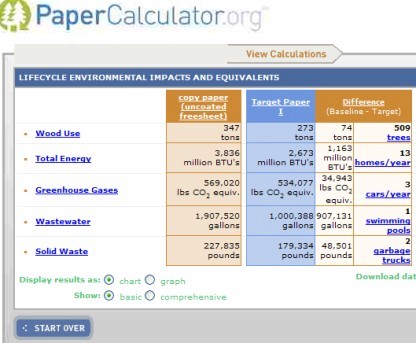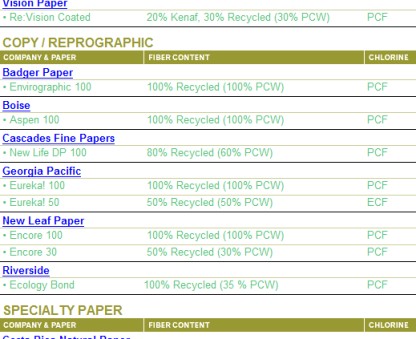General
Office Supplies Company Staples Ditches Polluting Paper Producer
The paper sector is an obvious a target for green activism, so this weekend’s breaking news that Staples, the big US office supplies retailer, severed all ties with its Singaporean paper supplier because of environmental concerns shouldn’t be that surprising. But the events that led to Staples’ move are rather interesting; a Wall Street Street Journal reporter had discovered that the company was going to use its Forest Stewardship Council (FSC) logo and tipped off the FSC about the environmental policies of APP.
APP’s paper producing methods have incited environmental concerns because it in part relies on natural rainforests. In recent years a hoist of US, Asian and European companies terminated their contracts with APP, one after the other. All cited environmental concerns as their reason. The giant retailer Office Depot Inc. was also in the list.
The WSJ reporter’s action resulted in the FSC’s objection to Staples’ use of its label (which is considered the world’s most stringent), which certifies responsible management of the world’s forests. A Staples spokesman last weekend told the Wall Street Journal “We decided engagement was not possible anymore. We haven’t seen any indication that APP has been making any positive strides [to protect the environment.]”. He added that staying in business with APP would come “at great peril to our brand.”
It’s obvious; Staples is concerned that its customers won’t be enamored with forest destructive paper production methods. APP has a policy of producing paper from newly planted forests but says that due to huge demand, it needs to cut trees from mature rainforests as well. This practice is, in the Wall Street’s Journal’s terms, ‘having an impact on big U.S. paper buyers’.
The big question now of course is whether APP, one of the world’s largest paper manufacturers, will stop its destruction. The incentive is rather limited; Staples purchased only around 9% of its total paper supplies from APP. The bulk of it was photocopy and office paper. The WSJ didn’t manage to get a reply from APP immediately, but perhaps later this week, when Staples officially announces its decision, there will be more information. Subscribe to this blog’s feed and stay posted.
The energy and pollution factors of various differing paper types can be calculated down to the amount of trees via a model devised by Environmental Defense. The calculator lists all the main paper types and enables you to compare them on energy usage, waste production, trees chopped down, greenhouse gases produced and waste water used. For instance, the difference between 100 tonnes of normal copy paper compared to 100 tonnes of glossy magazine paper is a whopping 509 trees and 34,943 lbs of greenhouse gases, not to speak of the other measures.

Despite these stunning numbers, the alternative to wood-sourced paper is by no means rosy, because recycling paper involves use of (rather mild) chemicals like sodium hydroxide and hydrogen peroxide. For starters, the recycled paper de-inked and bleached so all coloring is removed to prevent the paper from turning out too dark. The ensuing pulping process also involves plenty of chemicals.
For a detailed guide on various papers’ compositions, check out CeleryDesign. The breakdown is by papers’ fiber content, chlorine and weight.

There are three types of FSC certified papers, including a recently introduced ‘recycled’ label. To carry this label a material must be made from 100% recycled paper. To see which papers come with what kind of certification, visit the UK recycling debunker site LovelyAsATree.
Read Full Post | Make a Comment ( None so far )Groundhog Day’s Indian And European Backgrounds Are Remarkably Similar
A 15-year anniversary edition of the movie Groundhog Day has been released earlier this week. And that is a great idea; both the movie and the day’s real history are sublime.
 The comedy starring Bill Murray comes with a few delicious extras that were never shown before, including a colorful short about groundhogs and a ‘making-of’. There’s also a commentary by the people involved in the movie.
The comedy starring Bill Murray comes with a few delicious extras that were never shown before, including a colorful short about groundhogs and a ‘making-of’. There’s also a commentary by the people involved in the movie.
So what are Groundhog Day’s origins? Groundhog Day has a long tradition which can be traced back to both European Paganism and Indian culture. It is a weather divination and fertility rite that in Europe was known in its earliest form as Imbolc, a Gaelic word.
The tradition blew over to the Americas through German influence in the 18th Century. The early German settlers celebrated Candlemas Day which was the mid-point between the Winter Solstice and the Spring Equinox.
The German rite involved a badger but the animal was replaced by the groundhog when they landed in the US, the animal that was central to the similar Indian tradition. The groundhog is also known as the woodchuck, which is derived from the Indian legend of “Wojak, the groundhog”. Another name for the groundhog is whistlepig. The groundhog is a member of the Sciuridae family, which are large ground squirrels.
It had been a European custom to place a candle in the window on Candlemas Day. The candle would have been blessed by the priests of the Catholic church; an early Christian tradition that originated in pagan customs. Candlemas Day followed one day after Briget’s Day, which was the Catholic version of the Celtic fertility goddess Brigid. Saint Bridget was an Irish saint who lived at the same time as Saint Patrick. It was the feast of Mary’s purification, which also is a tradition that continued on from a Pagan theme.
The word February’s etymology reveals this too. The Latin word Februa means “expiatory offerings”. The Pagan version of this rite is known as lupercalia, which was also a purification ritual, carried out by the Romans.
The weather conditions on Groundhog Day are undoubtedly among the best documented of all days of the year and research reveals that most years the rodent, looking for his shadow, doesn’t see one and returns underground. That means that Spring generally really starts when the Spring Equinox comes around on March 21.
The rich tradition surrounding Groundhog Day is associated with prediction most of all. The history reveals what we associate with the sun, warm weather and our perception of the year in a day to day fashion rather insightfully. About.com’s landscaping specialist David Beaulieu explains it this way; “Let’s say we wanted to mark off the progress of the earth’s annual revolution around the sun using the twelve divisions on the face of a clock, as if we were measuring, instead, the passage within a single day from dawn to dusk (6:00 a.m. to 6:00 p.m.). In this analogy, the winter solstice corresponds to dawn and would be at 6:00 a.m., the summer solstice at 12:00 noon. By this logic, the spring equinox and autumnal equinox would occur at 9:00 a.m. and 3:00 p.m., respectively, working clockwise. At 6:00 p.m. we would have come full-circle: it would be dusk, and we’d have as little sunlight as we had started out with, at dawn. The period that concerns us is that between the winter solstice and the spring equinox (that is, between 6:00 a.m. and 9:00 a.m.), the time when good weather is so close, and yet so far away. If we looked for the midpoint between these two junctures, it would be 7:30 a.m. on our imaginary clock — about February 2 (or a few days after), according to the calendar. It would be right around Groundhog Day, in other words.”
The tradition might have been imported to the US by German settlers, but just like it had been inspired by their ancestors, the customs were also known among the earliest Indians in the US.
The Delaware Indians in Pennsylviania that also feature in the movie, thought of groundhogs as their ancestors. “They settled Punxsutawney, Pennsylvania as a campsite halfway between the Allegheny and the Susquehanna Rivers”, according to Stormfax.com, a specialist site. “The Delawares considered groundhogs honorable ancestors. According to the original creation beliefs of the Delaware Indians, their forebears began life as animals in “Mother Earth” and emerged centuries later to hunt and live as men”, according to the site.
Incidentally, the name Punxsutawney comes from the Indian name for the location “ponksad-uteney”. It means “the town of the sandflies.”
Read Full Post | Make a Comment ( None so far )